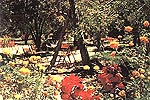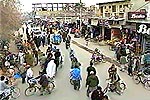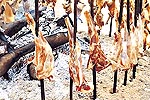 Physically, Quetta comprises of a series of long valleys 4500 5500-ft above sea level enclosed by the
Central Brahui range in the south and drained by the Pishin Lora
River and its tributaries. Quetta can righlty be called the fruit
basket of Pakistan. Its climate is dry and well-suited for the
cultivation of grapes, peaches, plums, apricots, apples, almonds,
pears, and pomegranates. Wheat, barley and corn are Quetta's most
common crops. Saffron grows very well on mountains around 5000 feet
high. It is being cultivated on a commercial scale. While Felts,
Rugs, Silk Embroidery and Copper Vessels are Quetta's major
handicrafts.
Physically, Quetta comprises of a series of long valleys 4500 5500-ft above sea level enclosed by the
Central Brahui range in the south and drained by the Pishin Lora
River and its tributaries. Quetta can righlty be called the fruit
basket of Pakistan. Its climate is dry and well-suited for the
cultivation of grapes, peaches, plums, apricots, apples, almonds,
pears, and pomegranates. Wheat, barley and corn are Quetta's most
common crops. Saffron grows very well on mountains around 5000 feet
high. It is being cultivated on a commercial scale. While Felts,
Rugs, Silk Embroidery and Copper Vessels are Quetta's major
handicrafts.
The Quetta division was constituted in 1955. It is a mountainous
region bounded by The Solomon Range on the East and The TobaKakar
Range at the North, thus separating it from Afghanistan.
 At the South-End of Chaman (near Afghan border) are the Khawaja Amran and Sarl Ath ranges. Across the
former lies the famous Khojak Pass with the Shelabagh railway tunnel
piercing 2.5 miles (4 km) of solid rock. From Nushki (Southwest of
Quetta city) to Dalbandin (Southwest of Nushki), the division
consists of a levelled sandy plain. Amongst its chief rivers are
Dalbandin and Pishin Lora. Rainfall is scarce in these parts of
Pakistan therefore cultivation mostly depends upon irrigation from
Karezes (underground channels) in the sub-mountainous region and
springs and streams in the highlands. Wheat is the main Rabi
(Spring) crop while Jowar (sorghum) is the chief Kharif (autumn)
crop in the plains and Corn in the highlands. Apart from these crops
Cooking coal is mined at the Khost Area in Sibi and in the Sor
Range, east of Quetta.
At the South-End of Chaman (near Afghan border) are the Khawaja Amran and Sarl Ath ranges. Across the
former lies the famous Khojak Pass with the Shelabagh railway tunnel
piercing 2.5 miles (4 km) of solid rock. From Nushki (Southwest of
Quetta city) to Dalbandin (Southwest of Nushki), the division
consists of a levelled sandy plain. Amongst its chief rivers are
Dalbandin and Pishin Lora. Rainfall is scarce in these parts of
Pakistan therefore cultivation mostly depends upon irrigation from
Karezes (underground channels) in the sub-mountainous region and
springs and streams in the highlands. Wheat is the main Rabi
(Spring) crop while Jowar (sorghum) is the chief Kharif (autumn)
crop in the plains and Corn in the highlands. Apart from these crops
Cooking coal is mined at the Khost Area in Sibi and in the Sor
Range, east of Quetta.
Quetta is a major Tourist attraction. It envisages all the colors of
thrill, adventure and enjoyment. For shoppers, some prominent
bazaars of Quetta are on Shahrah-e-Iqbal (Kandahari Bazaar) and
Shahrah-e-Liaquat (Liaquat Bazaar and Suraj Gang Bazaar). Here
tourists can find colorful handicrafts, particularly Balochi mirror
work embroidery which is admired all over the world. For Cuisine
crazy, there are lots of sumptuous dishes to feast upon. One
must-try balochi dish is their specialty called, "Sajji" (leg of
lamb), which is roasted to a delightful degree of tenderness and is
not very spicy.
 Perfect for tourists. One must also try the famous "Landhi" (the whole lamb), which is dried in
shade and kept for the winters. After enjoying a delicious meal one
can take some sightseeing tours in and around Quetta. The
Archaeological Museum at Fifa Road has a collection of rare antique
guns, swords and manuscripts while the Geological survey Department
on Sariab road has an attractive collection of rocks and fossils.
For Nature Lovers there is the 'Hazarganji Chiltan National Park',
which is located some 20 kms south-west of Quetta. The name
Hazarganji literally means "Of a thousand treasures" and indeed this
Park contains hundreds and thousands of natural treasures catching
the attention of travellers. Those in search of Fauna may find a
wide variety of Mammals like Markhors, "Gad" (wild sheep), leopards,
wolves, hyena, hares, wild cats and porcupines while Birds may
contain species of partridge, warblers, shikras, blue rock pigeon,
rock nuthatch, golden eagle, sparrows, hawks, falcons and bearded
vultures etc. Coming to the Flora of Quetta, one may find about 225
species of some pretty exotic plants like; pistachios, juniper, wild
olives, wild ash and wild almonds. Also found amongst such Flora are
wide range of shrubs like; wild fig, barbery, wild cherry, makhi and
herbs like; Ephedra intermadia, gerardiana etc. Apart from these
wonders of nature travellers may also take some interesting
excursions to places like Karkhasa, Urak Valley, Hanna Lake, Pishin,
Ziarat, Chashma, Zindra etc. In fact there are so many places to go
and so much to see that tourists need alot of time to enjoy and
cherish the moods and tastes of all. Quetta is truly a wonder, of
wonders!!
Perfect for tourists. One must also try the famous "Landhi" (the whole lamb), which is dried in
shade and kept for the winters. After enjoying a delicious meal one
can take some sightseeing tours in and around Quetta. The
Archaeological Museum at Fifa Road has a collection of rare antique
guns, swords and manuscripts while the Geological survey Department
on Sariab road has an attractive collection of rocks and fossils.
For Nature Lovers there is the 'Hazarganji Chiltan National Park',
which is located some 20 kms south-west of Quetta. The name
Hazarganji literally means "Of a thousand treasures" and indeed this
Park contains hundreds and thousands of natural treasures catching
the attention of travellers. Those in search of Fauna may find a
wide variety of Mammals like Markhors, "Gad" (wild sheep), leopards,
wolves, hyena, hares, wild cats and porcupines while Birds may
contain species of partridge, warblers, shikras, blue rock pigeon,
rock nuthatch, golden eagle, sparrows, hawks, falcons and bearded
vultures etc. Coming to the Flora of Quetta, one may find about 225
species of some pretty exotic plants like; pistachios, juniper, wild
olives, wild ash and wild almonds. Also found amongst such Flora are
wide range of shrubs like; wild fig, barbery, wild cherry, makhi and
herbs like; Ephedra intermadia, gerardiana etc. Apart from these
wonders of nature travellers may also take some interesting
excursions to places like Karkhasa, Urak Valley, Hanna Lake, Pishin,
Ziarat, Chashma, Zindra etc. In fact there are so many places to go
and so much to see that tourists need alot of time to enjoy and
cherish the moods and tastes of all. Quetta is truly a wonder, of
wonders!!


